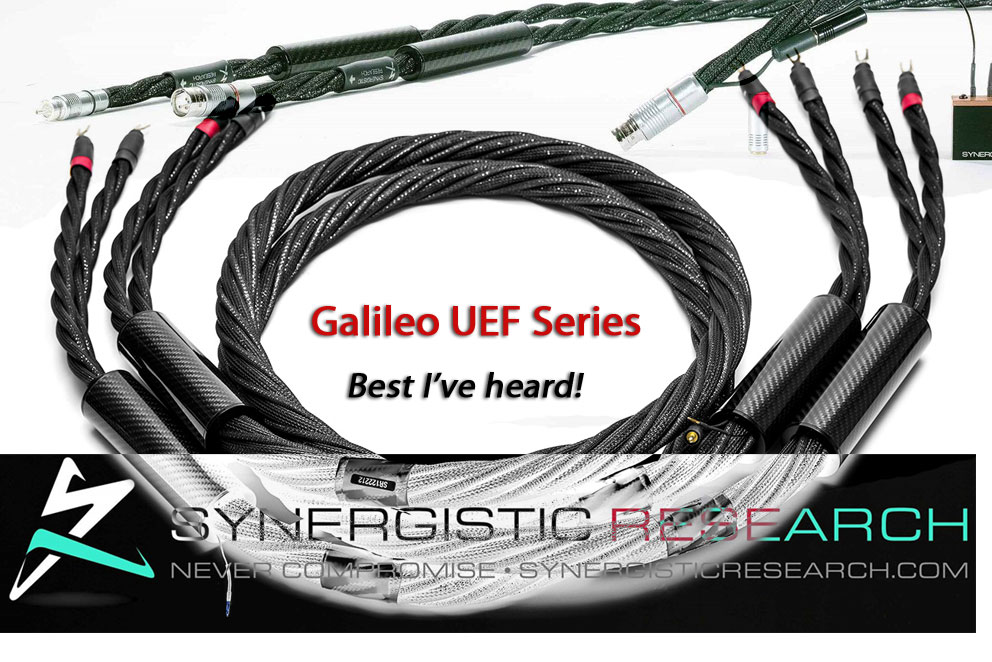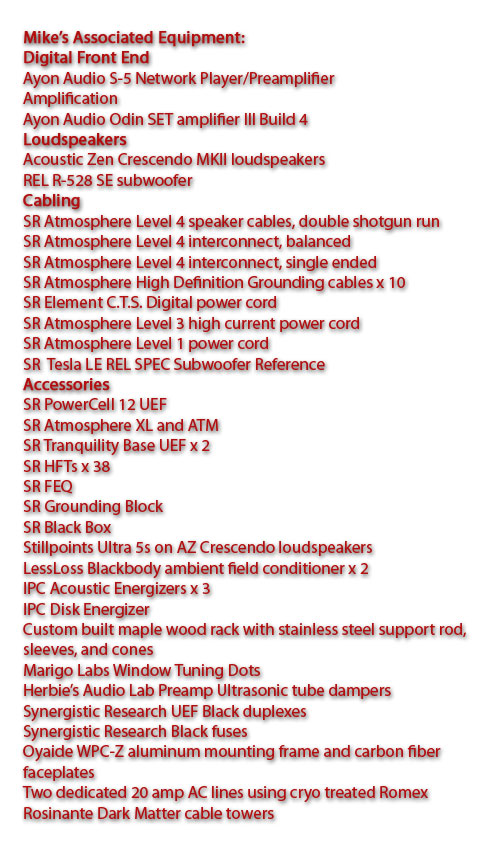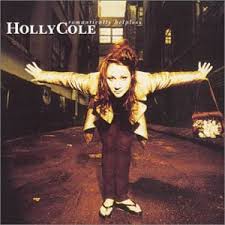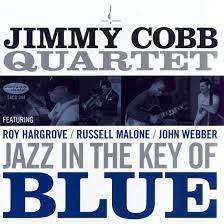Synergistic Research Galileo UEF Series Cables

 Some two years ago, I reviewed the Synergistic Research UEF Atmosphere Level 4 speaker cables and interconnects cables (here). At that time the SR UEF Atmosphere Level 4 outshined my reference cables adding to the long list of excellent SR products that have become a fixture in my system. Since June of last year, my system has been upgraded on many fronts which included the SR Atmosphere XL room tuning system, SR Atmosphere 12 UEF power conditioner, Ayon Audio Odin III SET amplifier and Acoustic Zen Crescendo MKII speakers, all of which I’ve owned previous models of in one form or another. Having gone down this path as of late, I’ve always wondered how much better the Synergistic Research Galileo series cables would integrate in my system considering they are a culmination of 25 years of SR cable design technology.
Some two years ago, I reviewed the Synergistic Research UEF Atmosphere Level 4 speaker cables and interconnects cables (here). At that time the SR UEF Atmosphere Level 4 outshined my reference cables adding to the long list of excellent SR products that have become a fixture in my system. Since June of last year, my system has been upgraded on many fronts which included the SR Atmosphere XL room tuning system, SR Atmosphere 12 UEF power conditioner, Ayon Audio Odin III SET amplifier and Acoustic Zen Crescendo MKII speakers, all of which I’ve owned previous models of in one form or another. Having gone down this path as of late, I’ve always wondered how much better the Synergistic Research Galileo series cables would integrate in my system considering they are a culmination of 25 years of SR cable design technology.

Galileo UEF Loudspeaker and Interconnect Cables
As one who has had an interest in audio cable design over the years, I can safely say the technology used in the design of the Galileo UEF cables is the most complex I’ve seen and yet they are priced the same as the former LE model and 60% less than the first generation model. The design attributes common to all Galileo UEF cables (speaker and interconnect) are the following:
· Multilayer Uniform Energy Field (UEF) Inductive fibers that condition the music signal outside the signal path, are made up of pure silver foils and graphene conductors and Japanese silk dielectrics, are electrically connected to each cable’s individual shields and are housed in a carbon fiber cylinder. The design allows for star grounding all cable shields which results in an increase your system’s signal to noise ratio by providing a path to remove excess charge and static.
· Galileo UEF Turning Modules are connected to the UEF cable shields and work outside the signal path by changing the resonance between signal and ground conductors which allow custom voicing of one’s system (connection is optional and combining both types is possible):
o Silver UEF- fast resonator that enhancing clarity and detail with pin point soundstage balance.
o Gold UEF – slower resonator that enhancing warmth and musicality filled with soundstage bloom
· Individual and isolated UEF strings consisting of tungsten and silver matrix alloy conductors coupled with silver monocrystal filaments housed in air dielectric PTFE tubes not resembling typical litz construction of multiple insulated strands of wire twisted, braided, or woven together in a single bundle.
· All conductors and shield are quantum tunneling using 1M volts of electricity.
· Graphene conductors and shield are integrated within the cable matrix.
· All cables are handmade in the Synergistic Research California factory plant.

Galileo UEF Speaker Cables
Each Galileo UEF Speaker Cable features 10 UEF isolated geometries running in parallel through 2 Uniform Energy Field Cells comprised of precious metal foils with Teflon and Japanese silk dielectrics. Each speaker cable is voiced with (2) separate UEF Tuning Circuits for a total of 3 individual tuning options for perfect system integration. Galileo UEF Speaker Cable Specifications:
Uniform Energy Field Cells:
· Count- 4 UEF Cells per pair
· Internal Conductor Material- 99.9999 Pure Silver and Pure Oxygen Free Copper
· Dielectric- TEFLON and Pure Japanese Silk
· Chassis Material- Carbon Fiber Strings:
· Silver Air Strings- 99.999% pure silver signal conductor, Air (sealed) dielectric
· Tungsten Air String- 99.9999% pure tungsten conductor, Air (sealed) dielectric
· Tricon String- 99.999% pure silver signal conductors, Teflon dielectric
· Graphene is used in strings as well as UEF filtration
· High Current Galileo String- Silver Matrix conductors, Modified PE dielectric
· UEF Ground Plane System
Each Galileo UEF Speaker Cable is actually 10 separate pair of cables which consist of 4 pair high current Galileo Silver Matrix Strings, 1 pair Tricon Strings, 1 pair Silver Air Strings, 1 each Tungsten Air String , and 1 each Silver UEF Ground Shield. A high definition ground plane wire system is employed for grounding and precious metals/graphene/silk and Teflon dielectrics make up the UEF Filtration.
Galileo UEF Interconnects
Galileo UEF Interconnects feature 2 isolated UEF geometries for RCA and 5 isolated UEF geometries for XLR running in parallel through 2 Uniform Energy Field Cells comprised of precious metal laminates with Teflon and Silk dielectrics. Each cable is voiced with a single UEF Tuning Circuit per interconnect for 2 individual tuning options. Galileo UEF Interconnect Specifications:
Uniform Energy Field Cells:
· Count- 2 UEF Cells per pair
· Internal Conductor Material- 99.999 Pure Silver, 99.9999 Pure Copper
· Dielectric- Teflon
· Chassis Material- Carbon Fiber Air Strings:
· 99.999% pure silver conductors with a separate ground conductor from shield
· Graphene- used for signal propagation and shielding
· Dielectric- Air (sealed)
· Shielding- UEF Ground Plane System
· Geometry- three channel single ended / five channel balanced geometry
Each Pair of Galileo UEF Interconnects are actually 3 separate pair of cables for RCA and 5 separate pair of cables for XLR. A high definition ground plane wire system is employed for grounding and precious metals/graphene/silk and Teflon dielectrics make up the UEF Filtration.
The Galileo UEF cables are a third generation product. The main differences between the Galileo UEF and LE series cables is the use and integration of Graphene conductor/shields and the elimination of active shielding (aka wall warts) that provide the DC current for the active shielding and electromagnetic power conditioning. SR is the world’s first cable company to incorporate Graphene, a new, highly conductive material that consists of a layer of pure carbon a single molecule thick and is almost a superconductor at room temperature. My review will compare the Atmosphere Level 4 series cables (bi-wired speaker and interconnects) to a Galileo UEF series cables.
No Filter LOL Part II
 My reviewing system includes the Ayon Audio S-5 Network Player/Preamplifier, Ayon Audio Odin III Gen 4 amplifier fitted with Tungsram signal tubes, Acoustic Zen Crescendo MKII loudspeakers, REL R-528SE subwoofer, SR Atmosphere Level 4 speaker cables and interconnects, SR CTS Element REL SPEC Subwoofer Reference cable, SR UEF power cords, SR PowerCell 12 UEF, SR UEF Black outlets, SR HFTs, SR Atmosphere XL, SR FEQ, SR Grounding Block and HDG cables, SR Black Box, SR MiGs isolation footers and SR Tranquility Bases UEF. My AZ Crescendo speakers are 24” from the front wall with the listening position 8.5 feet from the front baffle. My listening area, its 14.5’ wide, has a 9’ ceiling, and has an open back wall to 1500 sq ft of first floor living area.
My reviewing system includes the Ayon Audio S-5 Network Player/Preamplifier, Ayon Audio Odin III Gen 4 amplifier fitted with Tungsram signal tubes, Acoustic Zen Crescendo MKII loudspeakers, REL R-528SE subwoofer, SR Atmosphere Level 4 speaker cables and interconnects, SR CTS Element REL SPEC Subwoofer Reference cable, SR UEF power cords, SR PowerCell 12 UEF, SR UEF Black outlets, SR HFTs, SR Atmosphere XL, SR FEQ, SR Grounding Block and HDG cables, SR Black Box, SR MiGs isolation footers and SR Tranquility Bases UEF. My AZ Crescendo speakers are 24” from the front wall with the listening position 8.5 feet from the front baffle. My listening area, its 14.5’ wide, has a 9’ ceiling, and has an open back wall to 1500 sq ft of first floor living area.
Cables are the conduit that carries the music signal from source to amplifier and from amplifier to loudspeakers. Cables should be able to maintain a high resolution of low-level details that brings instruments and vocalists including the space they perform in to life; a neutral tonal balance; a transparency to sources revealing differences in mastering methods/equipment; dynamic expression independent of volume; and should be free of RFI, hum, and other noise source compression. In the past, reviewing cables was a difficult task at best since the differences between cables within the same price range seemed to achieve nearly equal levels of performance with some marginally better in some areas. But in the reference to the new Galileo UEF speaker and interconnect cables, the improvements over my previous reference are significant in profound ways which I will present below.
 Kicking back for a listen to the album “Romantically Helpless” by Holly Cole [Alert Records] after allowing for the Galileo UEF interconnects and speaker cables to settle in, proved to be an ear opening experience. This was the Canadian singer’s sixth full-length studio album bringing together the different facets of Holly’s music. Working with Grammy-award winning producer Steve Ferrera, this recording combines Tin Pan Alley classics such as Come Fly With Me, Don’t Fence Me In and That Old Black Magic with gems from some of the finest contemporary songwriters including Randy Newman (Ghosts, Same Girl), Paul Simon (One Trick Pony), Laura Harding (If I Start to Cry, Make It Go Away) and Cole’s own long-standing band mates, David Piltch (Romantically Helpless, I’ll Be Here) and Aaron Davis (Make It Go Away). I’ve always admired how Hole Cole could phrase a lyric like a horn yet never losing the thread of the story or the mood that she’s trying to create lyrically. In her own words, “I look at the essence of a song. If it’s a great lyric I often love to slow it down, explore it, dissect it and deconstruct it. I love to take it apart and put it back together and look at in an entirely different way. In the process, it often becomes a darker tune. That’s a huge part of my art form, that’s a huge part of what I do.” Understatement and restraint are words to describe Holly Cole’s vocal expression throughout the album.
Kicking back for a listen to the album “Romantically Helpless” by Holly Cole [Alert Records] after allowing for the Galileo UEF interconnects and speaker cables to settle in, proved to be an ear opening experience. This was the Canadian singer’s sixth full-length studio album bringing together the different facets of Holly’s music. Working with Grammy-award winning producer Steve Ferrera, this recording combines Tin Pan Alley classics such as Come Fly With Me, Don’t Fence Me In and That Old Black Magic with gems from some of the finest contemporary songwriters including Randy Newman (Ghosts, Same Girl), Paul Simon (One Trick Pony), Laura Harding (If I Start to Cry, Make It Go Away) and Cole’s own long-standing band mates, David Piltch (Romantically Helpless, I’ll Be Here) and Aaron Davis (Make It Go Away). I’ve always admired how Hole Cole could phrase a lyric like a horn yet never losing the thread of the story or the mood that she’s trying to create lyrically. In her own words, “I look at the essence of a song. If it’s a great lyric I often love to slow it down, explore it, dissect it and deconstruct it. I love to take it apart and put it back together and look at in an entirely different way. In the process, it often becomes a darker tune. That’s a huge part of my art form, that’s a huge part of what I do.” Understatement and restraint are words to describe Holly Cole’s vocal expression throughout the album.
One Trick Pony takes on whole new resonances as Holly Cole gets to a subtext Paul Simon may have never known existed. With the Galileo UEF cables, I immediately heard a more natural tonal balance, more holographic presence, a lower noise floor, and soundstage that were more uniformly constructed. Musical lines within complex arrangements were more clearly revealed with enhanced clarity with all instruments (bass, drums, guitar, piano, etc.) on each recording having greater spatial definition, revealed with greater accuracy, and were fuller, richer, and more complex in presentation. The more realistic portrayal of the soundstage and sense of space had the effect of detaching the music from the speakers. Images of instruments were displayed well past speaker boundaries on many cuts within this album. It was evident that Ferrera decided to build the entire album around Holly’s voice from the ground up. The system improvements brought by the Galileo UEF cables where additive; Holly’s voice was more organic and had greater presence, allowing me to better connect with the mood that was lyrically intended.
Convincingly, the edge on the music was completely gone. I marveled at how much musical detail that was previously obscured by noise was now exposed leading to a sense of discovery with each reference album played. The increased dynamics and its ability to communicate the emotional context of the recording was readily apparent with the Galileo UEF cables. The greater complexity of the microdynamic shadings that was more easily discerned brought the music to life when playing the album Elixir by the contemporary smooth jazz quartet Fourplay [Warner Brothers]. Again, the greater resolution across the full frequency spectrum brought on by swapping the Galilieo UEF cables in my system allowed me to rediscover my music collection all over again.
 I’ve spent many hours over the last few months enjoying the album, The Jimmy Cobb Quartet, “Jazz In The Key Of Blue” [Chesky Records]. The most famous work of the mostly self-taught musician, Jimmy Cobb, was on Miles Davis’ “Kind of Blue.” On this Chesky Records recording, Jimmy Cobb partners with past collaborators, Roy Hargrove and John Webber and guitarist Russell Malone for a collection of standards. Cobb’s delicate cymbal work, fine brush strokes, and gentile rim shots distinguished themselves from the other instruments in way that gave me an appreciation of his artistry and band leadership.
I’ve spent many hours over the last few months enjoying the album, The Jimmy Cobb Quartet, “Jazz In The Key Of Blue” [Chesky Records]. The most famous work of the mostly self-taught musician, Jimmy Cobb, was on Miles Davis’ “Kind of Blue.” On this Chesky Records recording, Jimmy Cobb partners with past collaborators, Roy Hargrove and John Webber and guitarist Russell Malone for a collection of standards. Cobb’s delicate cymbal work, fine brush strokes, and gentile rim shots distinguished themselves from the other instruments in way that gave me an appreciation of his artistry and band leadership.
All aspects of the improvements brought by the Galileo UEF cables discussed above were confirmed on this album. Listening to the first cut, When I Say Goodbye, I immediately noticed the absence of the whitish gray noise that I didn’t know existed with the Atmosphere Level 4 cables installed. It’s only after hearing your system with this distortion removed that you recognize this distortion for what it really is. With the whitish gray noise removed, the music through the Galileo UEF cables made it easier to forget I’m listening to electronics and loud speakers which allowing me to better hear the musical relationships between instruments or sections as though for the first time. The Galileo UEF cables were uncanny at revealing previously hidden details, dynamic gradations, and harmonic nuances present in the original recording that was not present on the Atmosphere Level 4 cables. Cobb’s delicate brushwork had better coherence and displayed more color as the brushes moved across the drumhead and depending on which cut on this album, it was also easier to place each instrument within the soundstage (front to back perspective) with the trumpet as played Roy Hargrove as big as my room. “Organic” is the one word I frequently noted during the review period of the Galileo UEF cables.
I commend SR for the implementation of the Galileo UEF Turning Modules. The impact on the music provided by the Galileo UEF Turning Modules was at the same time profound and beneficial. The flexibility in system tuning afforded by the Galileo UEF Turning Modules should allow integration of these state of the art cables in many music systems. In my vacuum tube based system, I preferred the Silver bullet on the single ended interconnect and Gold bullet on the speaker cables which provided the best of both worlds.
Conclusion
Although the Atmosphere UEF Level 4 cables are excellent cables within their price point, the technology employed in the Galileo UEF cables significantly improved upon the performance of the Atmosphere UEF Level 4 cables. Inner detail, low level musical signal retention, and the ability for the listener to easily pinpoint outlines within a well-defined soundstage were exemplary through the Galileo UEF cables. Instruments and vocals sounded lifelike and not electrically constructed through the Galileo UEF cables. The lower noise floor conferred many benefits in the areas of micro and macrodynamics which for me, is at the heart of enjoying recorded music… I have a new reference.

Mike Girardi
Specifications:
Galileo UEF, 8ft pair speaker cables, $15,000.00
Galileo UEF, 1m RCA interconnect, $7,500.00
Address:
Synergistic Research
Synergistic Research Inc.
1736 E. Borchard Ave.
Santa Ana, CA 92705
949-476-0000
Website: www.synergisticresearch.com
Phone numbers: (800) 578-6489 within US and (949) 476-0000 outside the US
Stereo Times Masthead
Publisher/Founder
Clement Perry
Editor
Dave Thomas
Senior Editors
Frank Alles, Mike Girardi, Russell Lichter, Terry London, Moreno Mitchell, Paul Szabady, Bill Wells, Mike Wright, and Stephen Yan,
Current Contributors
David Abramson, Tim Barrall, Dave Allison, Ron Cook, Lewis Dardick, John Hoffman, Dan Secula, Don Shaulis, Greg Simmons, Eric Teh, Greg Voth, Richard Willie, Ed Van Winkle, Rob Dockery, Richard Doran, and Daveed Turek
Site Management Clement Perry
Ad Designer: Martin Perry





Be the first to comment on: Synergistic Research Galileo UEF Series Cables